The Guard
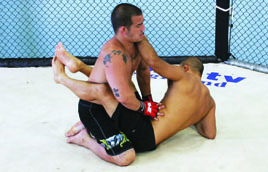
The Guard
I’ve seen many excellent jiu-jitsu practitioners forget about submissions and sweeps when they find themselves in the bottom guard position in MMA competition. Instead of working their jiu-jitsu, they throw an assortment of strikes in an attempt to knock their opponent out. It wouldn’t be so bad if they used strikes to help set up submissions, but often times they don’t. They simply get comfortable striking from their backs. Unless you land a strike just right or get extremely lucky and manage to open a cut, you generally aren’t going to end a fight with strikes while lying on your back. You can irritate your opponent and you can force movement with strikes, but usually the only way you can end a fight from the bottom guard position is with a submission. For this reason, you should think of the bottom guard in straight jiu-jitsu terms. You have to tailor your jiu-jitsu to deal with incoming strikes, but your goals on the bottom should be purely jiu-jitsu oriented. The three goals you want to work for are a submission, a sweep, or an escape back to your feet. It is important to focus on all three, not just submissions. If you’re up against a good ground and pound fighter who is a master at slipping out of submissions, he is going to make you pay every time a submission attempt fails. If you don’t use the movement your submission attempts generate to set up a sweep or an escape, you can quickly wind up a bloody mess.
Sit Up Guard
When an opponent postures up in your guard, his ability to lock in a submission is greatly reduced, while his ability to land strikes greatly increases. He can throw an assortment of punches, as well as pin your head to the mat and land brutal elbow strikes. Not wanting to be on the receiving end of a beating, I will usually sit up with my opponent by posting on one arm, and then drive my opposite elbow into his neck, face, and chin. Because I close the distance between us, it greatly reduces his ability to land strikes. He can still get off some punches to my body, but they certainly aren’t those devastating elbows to the face.
If your opponent should capitalize on his ability to throw body blows when you’re playing the sit up guard, it shouldn’t always be considered a negative. As long as your opponent is striking, he can’t hold you, which means you have mobility. Since you are already up on one arm, you can sometimes make a quick escape back to your feet when your opponent strikes. The whole idea behind the sit-up guard is to take the least amount of punishment while still working toward bettering your positioning.
Getting Up 101
A lot of people wonder how I get up from the bottom guard position when the fight goes to the ground. The answer is I utilize this technique. It’s one of the first moves that you learn in jiu-jitsu, but a lot of jiu-jitsu practitioners don’t practice it on a regular basis because they are content working off their backs, which often gets them into trouble in MMA. In order to become effective with this move, you must incorporate it into your training. Have a partner pin you down and unleash with ground and pound while you utilize this technique to get back to your feet. If you practice it again and again, eventually it will become second nature.
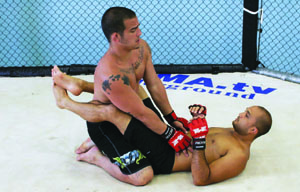
Troy is postured up in my closed guard.

Immediately I shoot my left arm up to the left side
of Troy’s head and come up onto my right elbow.
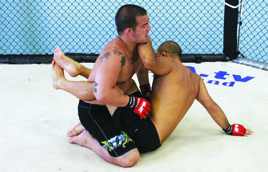
Driving the sharp side of my wrist into Troy’s neck,
I continue to sit up and post on my right hand.
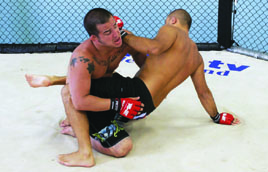
Driving my left arm into Troy’s neck, I unhook my
feet and post my left foot on the mat. This allows
me to elevate my hips, as well as turn them in a
clockwise direction.
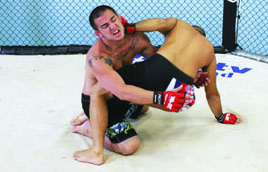
Driving my left hand into Troy’s head to create space,
I push off my left leg, further elevate my hips, and
begin pulling my right leg out.
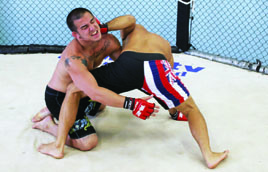
Still driving my left hand into Troy’s face, I pull my
right leg out and plant it on the mat behind me.
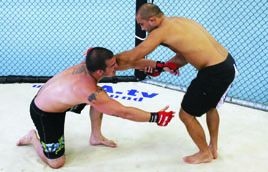
Posting on my right foot, I pull my left leg back to
create more space between Troy and I. To prevent
him from shooting in for the takedown, I continue to
hold him at bay with my left hand.
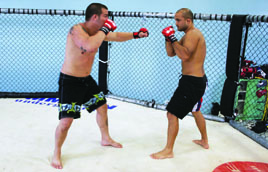
Pushing Troy away, I back all the way out and
assume my fighting stance.
Basic Hip Sweep
The basic hip sweep is an excellent technique because it flips your opponent over to his back and lands you in the mount. If your opponent should block the sweep by dropping his weight or posting his arm, it sets you up for either a guillotine or kimura. Below I demonstrate the sweep.
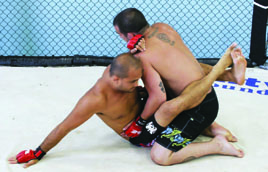
I’ve achieved the sit up guard position by driving my
left arm into Troy’s neck, sitting up, and posting on
my right hand. Right now my body is loaded like a
spring, and in order to get the sweep, all I have to
do is explosively turn by hips and scissor my legs.
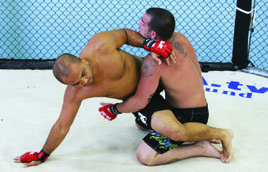
Unhooking my feet, I post my left leg on the mat and
elevate my hips. As I jam my left hip up into Troy’s
right armpit, I turn my body in a clockwise direction.
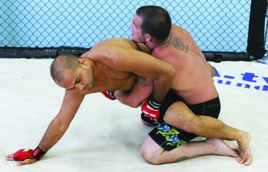
Continuing to turn my shoulders and hips in a
clockwise direction, I wrap my left arm over Troy’s
left arm. In addition to helping me carry him over
with the sweep, it also prevents him countering the
technique by posting his left hand on the mat.
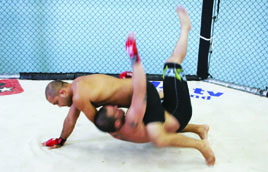
Because I was explosive with my movements,
Troy gets swept over to his back.
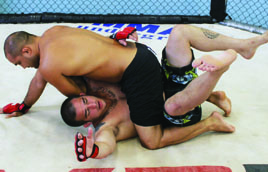
As Troy comes down to his back, I land in the
mount position.
I’ve seen many excellent jiu-jitsu practitioners forget about submissions and sweeps when they find themselves in the bottom guard position in MMA competition. Instead of working their jiu-jitsu, they throw an assortment of strikes in an attempt to knock their opponent out. It wouldn’t be so bad if they used strikes to help set up submissions, but often times they don’t. They simply get comfortable striking from their backs. Unless you land a strike just right or get extremely lucky and manage to open a cut, you generally aren’t going to end a fight with strikes while lying on your back. You can irritate your opponent and you can force movement with strikes, but usually the only way you can end a fight from the bottom guard position is with a submission. For this reason, you should think of the bottom guard in straight jiu-jitsu terms. You have to tailor your jiu-jitsu to deal with incoming strikes, but your goals on the bottom should be purely jiu-jitsu oriented. The three goals you want to work for are a submission, a sweep, or an escape back to your feet. It is important to focus on all three, not just submissions. If you’re up against a good ground and pound fighter who is a master at slipping out of submissions, he is going to make you pay every time a submission attempt fails. If you don’t use the movement your submission attempts generate to set up a sweep or an escape, you can quickly wind up a bloody mess.
Sit Up Guard
When an opponent postures up in your guard, his ability to lock in a submission is greatly reduced, while his ability to land strikes greatly increases. He can throw an assortment of punches, as well as pin your head to the mat and land brutal elbow strikes. Not wanting to be on the receiving end of a beating, I will usually sit up with my opponent by posting on one arm, and then drive my opposite elbow into his neck, face, and chin. Because I close the distance between us, it greatly reduces his ability to land strikes. He can still get off some punches to my body, but they certainly aren’t those devastating elbows to the face.
If your opponent should capitalize on his ability to throw body blows when you’re playing the sit up guard, it shouldn’t always be considered a negative. As long as your opponent is striking, he can’t hold you, which means you have mobility. Since you are already up on one arm, you can sometimes make a quick escape back to your feet when your opponent strikes. The whole idea behind the sit-up guard is to take the least amount of punishment while still working toward bettering your positioning.
Getting Up 101
A lot of people wonder how I get up from the bottom guard position when the fight goes to the ground. The answer is I utilize this technique. It’s one of the first moves that you learn in jiu-jitsu, but a lot of jiu-jitsu practitioners don’t practice it on a regular basis because they are content working off their backs, which often gets them into trouble in MMA. In order to become effective with this move, you must incorporate it into your training. Have a partner pin you down and unleash with ground and pound while you utilize this technique to get back to your feet. If you practice it again and again, eventually it will become second nature.

Troy is postured up in my closed guard.

Immediately I shoot my left arm up to the left side
of Troy’s head and come up onto my right elbow.

Driving the sharp side of my wrist into Troy’s neck,
I continue to sit up and post on my right hand.

Driving my left arm into Troy’s neck, I unhook my
feet and post my left foot on the mat. This allows
me to elevate my hips, as well as turn them in a
clockwise direction.

Driving my left hand into Troy’s head to create space,
I push off my left leg, further elevate my hips, and
begin pulling my right leg out.

Still driving my left hand into Troy’s face, I pull my
right leg out and plant it on the mat behind me.

Posting on my right foot, I pull my left leg back to
create more space between Troy and I. To prevent
him from shooting in for the takedown, I continue to
hold him at bay with my left hand.

Pushing Troy away, I back all the way out and
assume my fighting stance.
Basic Hip Sweep
The basic hip sweep is an excellent technique because it flips your opponent over to his back and lands you in the mount. If your opponent should block the sweep by dropping his weight or posting his arm, it sets you up for either a guillotine or kimura. Below I demonstrate the sweep.

I’ve achieved the sit up guard position by driving my
left arm into Troy’s neck, sitting up, and posting on
my right hand. Right now my body is loaded like a
spring, and in order to get the sweep, all I have to
do is explosively turn by hips and scissor my legs.

Unhooking my feet, I post my left leg on the mat and
elevate my hips. As I jam my left hip up into Troy’s
right armpit, I turn my body in a clockwise direction.

Continuing to turn my shoulders and hips in a
clockwise direction, I wrap my left arm over Troy’s
left arm. In addition to helping me carry him over
with the sweep, it also prevents him countering the
technique by posting his left hand on the mat.

Because I was explosive with my movements,
Troy gets swept over to his back.

As Troy comes down to his back, I land in the
mount position.
|
B.J. ‘the prodigy’ Penn is highly regarded by many to be pound-for-pound the best mixed martial artist in the world. After earning his black belt in just four years and dominating Brazilian jiu-jitsu competition, he entered mixed martial arts and took the real fighting world by storm. Penn is currently coaching the next season of the UFC’s “Tough Enough” reality show on Spike T.V. In his new book Mixed Martial Arts: The Book of Knowledge, Penn shares the philosophy and intricate techniques that have allowed him to defeat UFC champions such as Matt Hughes. |
Search Articles
Article Categories
Sort by Author
Sort by Issue & Date
Article Categories
Sort by Author
Sort by Issue & Date

